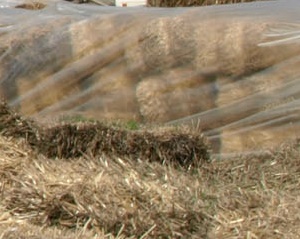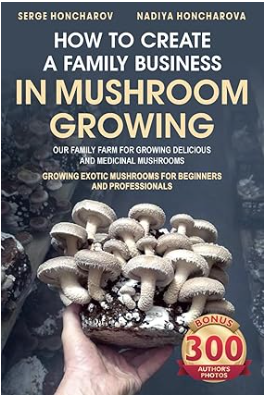
In this article, I’ll focus on how mixing different raw materials can improve oyster mushroom substrates. If you grow other wood-decay mushrooms, you may also find useful information in point 4.
Table of Contents
In this case, in addition to increasing the nutritional value of the composition, its physical structure also improves - this contributes to normal gas exchange in the mushroom block.
The nutritional value of the substrate is determined by the presence of both the main mineral elements and microelements.
In most cases, mushroom growers monitor only the nitrogen content, which should be at least 0.7 - 0.9.
Although the successful assimilation of nutrients by the mycelium is also associated with the presence of a certain amount of phosphorus, the ratio of C/N content, and the presence of many trace elements.
Therefore, by making a substrate composition from plants of different botanical species, you provide higher quality nutrition for mushrooms.
No, because even the same plant species can have different nutrient compositions depending on where they were grown.
To get an idea of nutrient content, you can look up scientific papers.
For example, the article "Cultivation of Mushrooms and Their Lignocellulolytic Enzyme Production Through the Utilization of Agro-Industrial Waste" includes a table showing the C/N ratios of various agricultural byproducts.
Some studies also compare yields when mixing different types of raw materials. These can be useful references when testing your own mixtures.
The best way to determine a good mix is through trial and observation.
When I say "observing" I mean "recording the results of each batch of blocks."
However, you should consider:
- Nitrogen content – different components contribute varying amounts.
- Hardness of plant material – tougher materials may need longer treatment times.

For example:
- Alfalfa straw is tough and pairs well with softer barley straw.
- Hay works best with wheat or rye straw.
- Husks can be added gradually while monitoring overgrowth and yield.
Yes! The way you process the substrate affects which mixtures work best:
👉 In lime treatment (also known as lime sterilization or cold treatment), substrate components are not mixed because they absorb moisture differently, can alter the pH of the solution, and require different weights to stay submerged.
If you want to experiment, soak them separately and then mix them when adding spawn before filling bags or buckets.
👉Hot water pasteurization (hydrothermy): Avoid complex mixtures. Each material requires a different steaming time. One component may absorb too much moisture, while another remains underprocessed.
This can slow mycelium colonization.
👉Steam treatment in a steaming chamber and tunnel pasteurization: These methods allow more flexibility in mixing materials. In both cases, the raw materials are mixed (often with lime), soaked, and then treated with steam at different temperatures depending on the method.
Legume hay is a great additive. It is rich in nutrients and helps heat the substrate during the pasteurization process.
Various additives are added to the substrate in order to improve productivity.
Experienced technologists often mix different types of raw materials to improve gas exchange in the block, but I mentioned this above.
Additives to the mushroom substrate depend on the method of processing the raw materials.
If you fill the substrate with hot water or disinfect the raw material with lime, any additives can cause mold spots to appear when the mycelium overgrows. You can try adding any legume hay, but not more than 10%.
However, I categorically do not recommend bran for such methods of processing raw materials.
Growers often add nutrients to boost yields, but this depends on how the substrate is processed.
- For hot water or lime pasteurization: Be careful with additives. Some, like bran, can lead to mold. Legume hay is a safer option, but it should not exceed 10% of the total mix. More about bran here
- For small-scale growers: You can experiment with adding boiled grains (wheat, barley, rice, or millet). After boiling, drain any remaining water. Then wrap the container in a blanket or another insulating material to keep the grains warm while they cool down slowly. Once cooled, mix them with grain spawn and add to the substrate. Try different amounts (10%, 15%, 20%) and observe the yield.

- Some hobby growers use a high percentage of grain spawn. I've read that some add anywhere from 10% to 20%.
However, this method is expensive and risky—too many nutrients can lead to contamination, as bacteria may colonize the substrate before the mycelium.
But if you're not facing contamination issues and just want to grow beautiful mushrooms (photo), why not? You can add as much spawn as you like.
- Can sawdust be a nutrient supplement?
No! Sawdust and wood shavings contain very little nitrogen.
They are only used in sterilized substrates, which must be supplemented with high-nitrogen additives to maintain the right balance.

One of the most popular mixtures is a blend of hardwood fuel pellets (HWFP) and soy hulls, known as "Master's mix." You can find more information about this online.
To prepare the pellets for use, pour hot water (about 70°C / 160°F) over them in a well-insulated container to retain heat.
The water-to-pellet ratio depends on the specific composition of the pellets, as different agricultural materials absorb moisture at different rates. This means you'll need to experiment to find the ideal soaking time for your particular batch.
What is the cheapest way to sterilize mushroom substrate?
If you're growing mushrooms as a hobby, you can try different methods of substrate disinfection.
But if mushroom cultivation is your business, finding the most effective processing method is crucial for maximizing productivity.
Not all growers have access to an autoclave. However, a low-cost method exists for sterilizing pellet-based substrates at atmospheric pressure.
Different mushroom species thrive on different types of pellets.

Some, like Cyclocybe aegerita, require a nitrogen-rich substrate, while others, like oyster mushrooms, do better with lower nitrogen levels.
The composition of the pellets affects not only the nutritional profile of the substrate but also the flavor of certain mushrooms, such as shiitake.
If you’re unsure how to create the best substrate mix for your mushrooms, it helps to follow proven methods instead of experimenting blindly.
My friend, an experienced mushroom-growing technologist, and his wife, also a mushroom cultivation specialist, wrote a detailed guide on setting up a small home farm.
In this book, they explain how to sterilize substrates using steam in small 200-liter containers at atmospheric pressure. They also provide tested blend ratios for different mushroom species and describe the optimal conditions for growing them.
👉 You can check out the book's table of contents and purchase it here.
